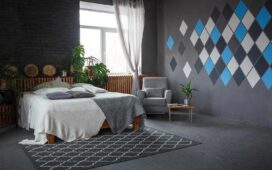Whether you live in a noisy apartment or have loud neighbors, soundproofing your space can make a significant difference in creating a peaceful environment. Many people assume that soundproofing requires expensive and complicated renovations that involve damaging walls or ceilings. However, there are many simple and affordable solutions that can help reduce noise without altering your property’s structure. In this blog post, we will explore some of the best ways to soundproof your home without causing any damage.
Whether you’re an apartment renter, a homeowner, or a business owner, soundproofing can make a significant difference
- Use curtains, blankets or rugs to absorb sound
One of the simplest solutions for soundproofing without damaging walls is to use curtains, blankets, or rugs to absorb sound. These soft materials can help to deaden sound and reduce echo within the room. Curtains can be hung over windows and walls to reduce the amount of outside noise that enters the room while creating an attractive soft furnishing. Blankets and rugs can be hung on walls to absorb sound and reduce reverberation.
When using these materials, it is important to select those that are thick and dense for maximum sound absorption. While these materials are effective for reducing sound transmission, they may not provide complete soundproofing and should be considered as part of a comprehensive soundproofing plan. Additionally, it is important to use hooks or clips to hang these materials without damaging the walls.
- Install soundproofing panels on walls or ceilings
If you want to reduce the amount of noise that enters or leaves your room without damaging your walls or ceilings, installing soundproofing panels can be an effective and simple solution. Acoustic panels are designed to absorb sound waves and prevent them from passing through surfaces, thereby reducing the amount of noise that travels through walls or ceilings. Installing these panels involves attaching them to the surface with adhesive materials or hanging them like posters.
These panels come in a variety of shapes, sizes, and colors that can be customized to match your room’s decor. However, keep in mind that you need to cover all exposed surfaces to achieve optimal results, and the thickness of the panels may affect the overall aesthetic of your space.
- Use acoustic foam tiles or panels
One of the most common and effective solutions for soundproofing walls is to use acoustic foam tiles or panels. Acoustic foam is designed to absorb sound energy, reducing the amount of noise that passes through walls. These foam tiles or panels come in a variety of sizes and shapes, making them perfect for almost any space. You can easily install them on walls and ceilings using adhesive, and they won’t leave any permanent damage or marks.
However, it’s important to note that acoustic foam won’t provide complete soundproofing for a room. It can only help to reduce the amount of noise that enters or leaves the space. Depending on your specific needs, you may need to combine acoustic foam with other soundproofing materials and techniques to achieve optimal results.
- Seal gaps around doors or windows with weatherstripping or acoustic sealant
One of the most effective and simple solutions to soundproofing without damaging walls is to seal gaps around doors or windows with weatherstripping or acoustic sealant. These gaps can allow noise to easily travel in and out of a room, especially if they are poorly insulated. Weatherstripping is a material specifically designed to keep out drafts and noise by filling gaps around doors and windows. It can be made of various materials such as foam, felt, or rubber and can be easily installed in minutes.
Acoustic sealant is a type of adhesive that dries as a flexible rubber seal, making it perfect for filling gaps or joints where sound can easily pass through. It’s important to note that weatherstripping and acoustic sealants can also help with energy efficiency by reducing heating and cooling costs. By utilizing these simple solutions, you can significantly reduce the noise that enters or exits a room.
In conclusion, there are several ways to minimize noise and soundproof a room without causing damage to the walls. From using sound-absorbing materials like rugs, curtains, and foam panels to installing soundproof curtains or door sweeps, there are several options available to help reduce noise levels. Additionally, utilizing simple techniques like rearranging furniture, adding bookshelves, or using thick blankets can have a significant impact. With these easy and practical solutions, anyone can effectively soundproof their room without causing any damage to the walls.













